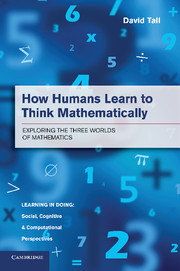Book contents
- Frontmatter
- Dedication
- Contents
- Series Foreword
- Journeys through three worlds of mathematics
- Preface
- Acknowledgements
- Illustration Credits
- I Prelude
- II School Mathematics and Its Consequences
- III Interlude
- IV University Mathematics and Beyond
- 10 The Transition to Formal Knowledge
- 11 Blending Ideas in the Calculus
- 12 Expert Thinking and Structure Theorems
- 13 Contemplating the Infinitely Large and Small
- 14 Expanding the Frontiers through Mathematical Research
- 15 Reflections
- Appendix Where It All Came From
- References
- Index
11 - Blending Ideas in the Calculus
from IV - University Mathematics and Beyond
Published online by Cambridge University Press: 05 June 2014
- Frontmatter
- Dedication
- Contents
- Series Foreword
- Journeys through three worlds of mathematics
- Preface
- Acknowledgements
- Illustration Credits
- I Prelude
- II School Mathematics and Its Consequences
- III Interlude
- IV University Mathematics and Beyond
- 10 The Transition to Formal Knowledge
- 11 Blending Ideas in the Calculus
- 12 Expert Thinking and Structure Theorems
- 13 Contemplating the Infinitely Large and Small
- 14 Expanding the Frontiers through Mathematical Research
- 15 Reflections
- Appendix Where It All Came From
- References
- Index
Summary
The calculus is the crowning glory of classical mathematics, giving us the power to calculate how things change (differentiation), how they build up (integration) and the relationship between the two (the fundamental theorem of calculus). These ideas can be embodied visually and dynamically as the changing slope of a curve and the area underneath the curve, which extend to a vast range of applications to calculate the rate of change of quantities and how they accumulate. Yet, over the centuries, the calculus has been the subject of ongoing critical debate.
Controversy persists precisely because the calculus deals with arbitrarily small quantities and potentially infinite processes. This problem was formally resolved in the nineteenth century by defining the limit concept in terms of a challenge, specifying the accuracy desired and seeking a way of calculating to within this desired accuracy. It involves the famous epsilon-delta approach: ‘tell me how close you would like to be (a positive value epsilon) and then I will tell you a value (delta) so that when the input is within delta, then the output is within epsilon.’
The introduction of the epsilon-delta challenge made it possible for expert mathematicians to build the modern theory of mathematical analysis, but, as we saw in Chapter 10, it is often problematic for students meeting the calculus for the first time. Their mathematical knowledge structures are based on the embodied world of geometry and graphs, and the symbolic world of arithmetic and algebra. These are related to a physical world in which objects move around in a continuous fashion and graphs are drawn continuously with a dynamic movement of the hand, where the word ‘continuous’ is used in an embodied dynamic sense, perceived through our senses. This form of continuity will be described as dynamic continuity, to distinguish it from the formal epsilon-delta definition of continuity given by the limit concept.
- Type
- Chapter
- Information
- How Humans Learn to Think MathematicallyExploring the Three Worlds of Mathematics, pp. 289 - 337Publisher: Cambridge University PressPrint publication year: 2013
- 1
- Cited by



